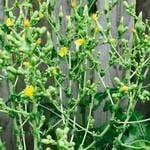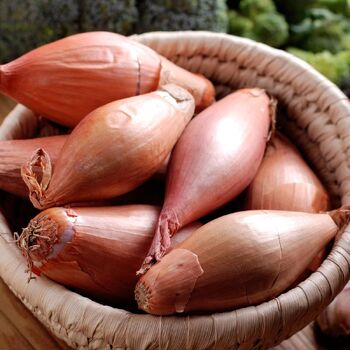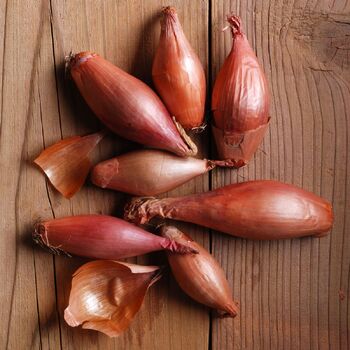
How to Grow Shallot from Seeds
Grow Guide #2904
Family: Amaryllidaeae
Binomial name: Allium cepa var. aggregatum
Life Cycle: Perennial (usually grown as an annual)
This 'How to Grow' guide details everything a home gardener needs to know to plant, grow and care for Shallots (Allium cepa var. aggregatum).
When to Sow Shallot Seeds
Shallot is a cool season crop. Use the table below to identify the best time of year to sow shallot in your climate.
| JAN | FEB | MAR | APR | MAY | JUN | JUL | AUG | SEP | OCT | NOV | DEC | |
|---|---|---|---|---|---|---|---|---|---|---|---|---|
| Cool | ||||||||||||
| Temperate | ||||||||||||
| Sub-Tropical | ||||||||||||
| Tropical | ||||||||||||
| Arid |
Preparation
Shallot plants are best grown in full sun. Choose a location that will receive at least 6 hours of full sun each day.
Shallot plants need a well drained soil enriched with plenty of organic matter. Prepare soil by weeding it thoroughly, digging it over to loosen it and adding aged animal manure or compost. Keep the area free of weeds until planting. Learn more about preparing soil for planting here.
How to Sow Shallot Seeds
Shallot seeds do not require any treatment (eg soaking, stratification) before sowing.
Shallot seeds can be sown directly into the garden OR seedlings can be raised in trays or other containers and transplanted to the garden once established.
Sow Direct
- Sow seeds directly in the garden 5mm deep and 5-10cm apart, with rows 40cm apart.
- Keep soil moist but never wet or dry.
- Seeds should germinate in around 7-10 days at a soil temperature of 20-25°C.
- Young seedlings will need protection from pests, pets and weather until they are established.
Raise Seedlings
- Fill trays, punnets or jiffy pots with a good quality seed-raising mix, or use soil starter pellets.
- Sow seeds 5mm deep.
- Keep soil moist but never wet or dry.
- Seeds should germinate in around 7-10 days at a soil temperature of 20-25°C.
- Transplant seedlings to the garden once they have their first true leaves and are large enough to handle (usually 5-10cm tall).
- Plant out, spacing plants 5-10cm apart, with rows 40cm apart.
Optional: As an alternative to sowing seeds individually, seeds can be sown in groups of 3-5 seeds with groups spaced 15cm apart. Thin to 3 seedlings per group; seedlings can then be grown together until harvest.
Tip: Shallot seeds are quite small. Handle them carefully to avoid them blowing away or being washed away. Mix seeds with sand or fine potting mix prior to sowing or use a seed dispenser, damp toothpick or tweezers to help space them evenly. Press lightly into the surface after sowing so that the seeds make good contact with the soil. Take extra care to make sure seeds and seedlings don’t dry out. Read more about sowing small seeds here.
How to Grow Shallot
Shallot plants may need watering during the growing season. Water when the soil is dry about 5cm below the surface (test this by scratching away a little soil with your finger). Water deeply in the early morning or late afternoon. Avoid watering the leaves of plants to avoid fungal diseases. Learn more about watering here.
If soil was well prepared no extra fertiliser should be necessary. Fertilising can result in excessive leaf growth at the expense of roots forming. In poor soil use a fertiliser low in nitrogen and high in phosphorus, such as blood and bone, applied at the recommended rate.
Optional: To give plants room to grow, thin seedlings when they are large enough to handle. Pull out any weak or small seedlings so plants are spaced about 5-10cm apart.
How to Harvest Shallots
Shallots should be ready to harvest in approximately 120 days.
Shallots are ready to harvest when the neck between the bulb and the leaves becomes soft and the leaves begin to fall over. Use a fork to gently lift the entire plant from the bed, shaking off the excess soil. It is a good idea to harvest a single plant first to make sure a bulb has formed; if the bulb is small or unformed, leave the remaining plants for 2-3 weeks then harvest and check another bulb.
Place the whole plants on wire racks or hang them in bunches, leaving them in a dry cool place for 2-3 weeks to cure. Bulbs with thick necks will not store well and should be eaten soon after harvest. For other bulbs, cut the dried leaves off 3-4cm above the bulb. Shallot bulbs can be stored in a cool dry place for up to 6 months.
Common Problems when Growing Shallots
Like all plants, shallot is susceptible to some pests, diseases and other problems. Below is a list of the most common problems gardeners encounter when growing shallot plants:
 Aphids are small (2-4mm long) sap-sucking insects that congregate on the new shoots or the undersides of leaves. They can cause leaves to wilt or become discoloured, and also excrete honeydew which can attract ants and other insect pests. To manage aphids, remove them by spraying with a garden hose, apply a soap or alcohol spray, or encourage predatory insects to your garden. Read more about aphids here.
Aphids are small (2-4mm long) sap-sucking insects that congregate on the new shoots or the undersides of leaves. They can cause leaves to wilt or become discoloured, and also excrete honeydew which can attract ants and other insect pests. To manage aphids, remove them by spraying with a garden hose, apply a soap or alcohol spray, or encourage predatory insects to your garden. Read more about aphids here. Bulbs not forming can be caused by harvesting too early, inconsistent watering or weather, planting bulbs or cloves that are too small, or too much nitrogen during the growing season. Plant varieties suited to your climate, do not over fertilise, water regularly and harvest after the leaves have started to die down.
Bulbs not forming can be caused by harvesting too early, inconsistent watering or weather, planting bulbs or cloves that are too small, or too much nitrogen during the growing season. Plant varieties suited to your climate, do not over fertilise, water regularly and harvest after the leaves have started to die down. Bolting is when a plant prematurely flowers and goes to seed. Bolting can be caused by a period of extreme weather. Avoid sowing seed until after the danger of frosts has passed or in very hot weather. Water plants regularly and deeply in hot weather to prevent them suffering heat stress.
Bolting is when a plant prematurely flowers and goes to seed. Bolting can be caused by a period of extreme weather. Avoid sowing seed until after the danger of frosts has passed or in very hot weather. Water plants regularly and deeply in hot weather to prevent them suffering heat stress. Rust (Puccinia sp.) is a fungal disease that causes brown to orange raised spots or patches to appear on foliage. Fungal spores are spread by wind or water to neighbouring plants, especially in temperatures of 10-20C and when humidity is high. To manage rust, space plants to avoid overcrowding, grow them in the recommended amount of light (eg full sun), do not over fertilise crops, remove dead plants and practice crop rotation. Read more about rust fungus here.
Rust (Puccinia sp.) is a fungal disease that causes brown to orange raised spots or patches to appear on foliage. Fungal spores are spread by wind or water to neighbouring plants, especially in temperatures of 10-20C and when humidity is high. To manage rust, space plants to avoid overcrowding, grow them in the recommended amount of light (eg full sun), do not over fertilise crops, remove dead plants and practice crop rotation. Read more about rust fungus here. Onion thrips (Thrips tabaci) are flying insects less than 1.5mm long with slender pale yellow to light brown bodies. They suck sap from plants, leaving silver patches on the leaves and reducing the productivity and yield of plants. Thrips can live in the inner leaves and leaf folds of alliums, and may also infest bulbs. Wash thrips from affected plants using a garden hose, spread an organic mulch around plants, and encourage predatory mites and lacewings with companion planting.
Onion thrips (Thrips tabaci) are flying insects less than 1.5mm long with slender pale yellow to light brown bodies. They suck sap from plants, leaving silver patches on the leaves and reducing the productivity and yield of plants. Thrips can live in the inner leaves and leaf folds of alliums, and may also infest bulbs. Wash thrips from affected plants using a garden hose, spread an organic mulch around plants, and encourage predatory mites and lacewings with companion planting.


.png)




